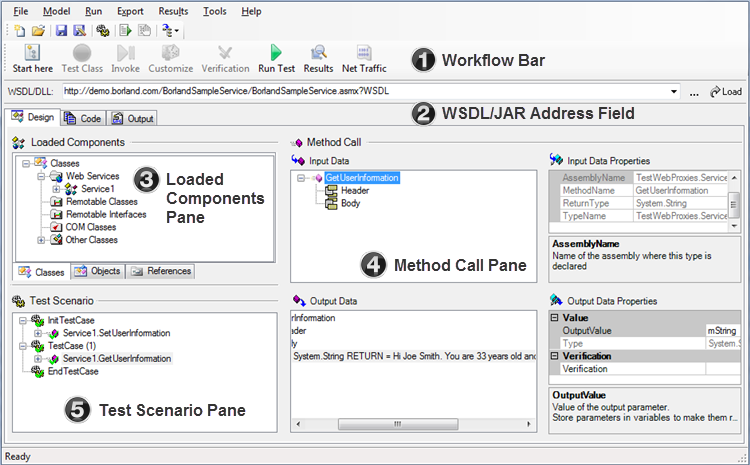Overview
The main sections of the .NET Explorer interface are highlighted below.

Workflow Bar
The .NET Explorer workflow bar assists you in configuring and running your tests. The buttons on the workflow bar enable you to perform the following commands:
- Start Here: Opens the Load File Wizard, which guides you through selecting the type of testing that you want to perform and loading the required components.
- Test Class: Allows you to create a new test case for a class, or to add methods to an existing test case. This button is enabled when you select a class in the Loaded Components menu tree.
- Invoke: Invokes the selected method in the Loaded Components menu tree and adds it to the selected test case in the Test Scenario menu tree.
- Customize: Lets you store data as variables. This button is enabled when you select an input parameter in the Input Data menu tree, or an output parameter in the Output Data menu tree.
- Verification: Allows you to define verifications for variables. This button is enabled when you select an output parameter in the Output Data menu tree that has been stored as a variable.
- Run Test: Performs an animated run of your test cases.
- Results: Lets you explore the results of your last test run through user report, TrueLog, error report, or log file analysis.
- Net Traffic: Displays the request and response network traffic of the method call that is selected in the Test Scenario menu tree.
WSDL/DLL Address Field
The WSDL/DLL address field allows for the loading of either WSDLs or .NET assemblies.
Loaded Components Pane
The
Loaded Components pane includes three tabs:
- Classes: A list of loaded Web services, remotable classes/interfaces and other .NET classes. Allows you to instantiate objects, connect to remote objects, or call static methods.
- Objects: A list of instantiated objects, global and random variables. Allows you to call methods on those kind of objects.
- References: A list of loaded files (assemblies, WSDL‘s).
Method Call Pane
- The Input Data menu tree shows input parameters (both headers and bodies) for the selected method call.
- The Input Data Properties field shows the properties of the input parameters (value, type, pass, null, etc).
- The Output Data menu tree shows the output parameters (header and body) of the last/selected method call.
- The Output Data Properties field shows the properties of the output parameters (value, type, pass, null, etc).
Test Scenario Pane
The Test Scenario pane lists the current test cases along with all added method calls.